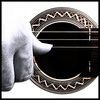Youtube Flamenco Guitar Lessons - Barrio La Viña (Alegria)
In this video you can watch and listen to the whole piece Barrio La Viña (Alegria) by Paco de Lucia (from El Duende Flamenco).
You can follow the links below to watch each flamenco guitar exercise separately:
01 - Flamenco Tremolo Exercise - 19 Barrio la Viña (Alegrias) INTRO by Paco de Lucia
02 - Pulgar Exercise - 28 - Barrio la Viña (Alegrias) by Paco de Lucia
03 - Pulgar Exercise - 29 - Barrio la Viña (Alegrias) by Paco de Lucia
04 - Mixed Technique Exercise - 8 - Barrio la Viña (Alegrias) by Paco de Lucia
05 - Pulgar Exercise - 30 - Barrio la Viña (Alegrias) FINALE by Paco de Lucia
Barrio la Viña is one of Paco de Lucia's beautiful alegrias from his 172 album El Duende Flamenco de Paco de Lucia. The piece presents a good opportunity to learn the alegria palo as it is not very difficult to figure out and play.
Paco plays Barrio la Viña freely without a rigid compas. However, to learn how to play alegria, I purposefully used my flamenco metronome. This way you can hear exactly where the accents go and the phrasing within the 12-beat structure works.
Alegria (or alegrias) is similar to buleria in that it is based on 12 beats. There are three major differences, though: a) the compas starts at 1; b) the tonality is "por arriba" that is E, and alegria is a joyful type of music as the title suggests; c) alegria is played more slowly than buleria
The video tutorials focus on various flamenco guitar techniques such as pulgar, arpeggio, picado, free stroke, alzapua, and rasgueado. The mixed technique video lessons incorporate several different techniques within a single falseta.
There are plenty of flamenco guitar tabs available over the internet ranging from acceptably accurate to completely wrong. I utilize different sources plus the original music itself to piece together something that is as correct as I my ears can discern :-) Besides, when you have a good video tutorial, you also receive a lesson in how to use your fingers to play the falseta.
For free flamenco guitar lessons, simply subscribe to the atrafanaSchool mailing list.
To learn flamenco guitar technique via a structured curriculum:
Total Training
You can follow the links below to watch each flamenco guitar exercise separately:
01 - Flamenco Tremolo Exercise - 19 Barrio la Viña (Alegrias) INTRO by Paco de Lucia
02 - Pulgar Exercise - 28 - Barrio la Viña (Alegrias) by Paco de Lucia
03 - Pulgar Exercise - 29 - Barrio la Viña (Alegrias) by Paco de Lucia
04 - Mixed Technique Exercise - 8 - Barrio la Viña (Alegrias) by Paco de Lucia
05 - Pulgar Exercise - 30 - Barrio la Viña (Alegrias) FINALE by Paco de Lucia
Barrio la Viña is one of Paco de Lucia's beautiful alegrias from his 172 album El Duende Flamenco de Paco de Lucia. The piece presents a good opportunity to learn the alegria palo as it is not very difficult to figure out and play.
Paco plays Barrio la Viña freely without a rigid compas. However, to learn how to play alegria, I purposefully used my flamenco metronome. This way you can hear exactly where the accents go and the phrasing within the 12-beat structure works.
Alegria (or alegrias) is similar to buleria in that it is based on 12 beats. There are three major differences, though: a) the compas starts at 1; b) the tonality is "por arriba" that is E, and alegria is a joyful type of music as the title suggests; c) alegria is played more slowly than buleria
The video tutorials focus on various flamenco guitar techniques such as pulgar, arpeggio, picado, free stroke, alzapua, and rasgueado. The mixed technique video lessons incorporate several different techniques within a single falseta.
There are plenty of flamenco guitar tabs available over the internet ranging from acceptably accurate to completely wrong. I utilize different sources plus the original music itself to piece together something that is as correct as I my ears can discern :-) Besides, when you have a good video tutorial, you also receive a lesson in how to use your fingers to play the falseta.
For free flamenco guitar lessons, simply subscribe to the atrafanaSchool mailing list.
To learn flamenco guitar technique via a structured curriculum:
Total Training
